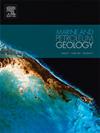Morphology and in-situ sulfur isotope characteristics of pyrite across the Ordovician-Silurian boundary marine shale in South China: Indicative significance for sedimentary environment
IF 3.7
2区 地球科学
Q1 GEOSCIENCES, MULTIDISCIPLINARY
引用次数: 0
Abstract
Pyrite plays a crucial role in the sulfur cycle, mirroring changes in global and local redox conditions within sedimentary environments across geological records. The grain size of framboidal pyrite effectively indicates the redox state of the sedimentary water column, while its sulfur isotope characteristics provide insights into early diagenetic history. However, variations in water column hydrodynamics can diminish the reliability of framboidal pyrite grain size distribution as an indicator of redox conditions. Bulk pyrite sulfur isotope measurements are often affected by later diagenetic processes. This study aims to investigate the impact of hydrodynamic conditions on framboidal pyrite grain size and to reconstruct the redox history across the Ordovician-Silurian boundary. To achieve this, we examined the morphology, grain size distribution of pyrite, total organic carbon, trace element abundances in the Wufeng (Ordovician)-Longmaxi (Silurian) formation in South China. The results indicate that enhanced hydrodynamic conditions driven by upwelling led to a significant increase in the average grain size of framboidal pyrite formed in reducing environments, as well as greater grain size variability. We also conducted in situ sulfur isotope analyses on two framboidal pyrite grains from the top of the Wufeng Formation and the base of the Longmaxi Formation. A response model was developed to illustrate the relationship between grain-scale δ34Spyr distribution and sea-level fluctuations. Ultimately, the redox evolution across the Ordovician-Silurian boundary in the Weiyuan area was reconstructed into five stages: (1) The upper Wufeng Formation experienced intensifying reducing conditions, culminating in euxinia at the top. (2) Oxidizing conditions briefly prevailed at the base of the Longmaxi Formation. (3) Oxygen levels in the sedimentary waters of the lower Longmaxi Formation decreased, stabilizing in a prolonged dysoxic-euxinic state. (4) The middle-lower Longmaxi Formation saw a gradual increase in the oxidative state of the sedimentary waters, transitioning to an oxic environment. (5) The middle Longmaxi Formation's sedimentary waters sustained a long-term dysoxic-oxic state.
华南奥陶—志留系界线海相页岩中黄铁矿形态及原位硫同位素特征:沉积环境指示意义
黄铁矿在硫循环中起着至关重要的作用,反映了地质记录中沉积环境中全球和局部氧化还原条件的变化。草莓状黄铁矿的粒度特征有效地指示了沉积水柱的氧化还原状态,而其硫同位素特征则为早期成岩历史提供了线索。然而,水柱流体动力学的变化会降低草莓状黄铁矿粒度分布作为氧化还原条件指标的可靠性。块状黄铁矿硫同位素测量常常受到后期成岩作用的影响。本研究旨在探讨水动力条件对菱形黄铁矿粒度的影响,并重建奥陶系-志留系界线的氧化还原历史。为此,研究了中国南方奥陶系五峰组—志留系龙马溪组黄铁矿的形态、粒度分布、总有机碳、微量元素丰度等特征。结果表明,上升流驱动的水动力条件增强导致还原环境下形成的草莓状黄铁矿的平均晶粒尺寸显著增大,晶粒尺寸变动性更大。对五峰组顶部和龙马溪组底部的两个草莓状黄铁矿颗粒进行了原位硫同位素分析。建立了粒度δ34Spyr分布与海平面波动关系的响应模型。最终,将威远地区奥陶系—志留系界线上的氧化还原演化过程重构为5个阶段:①上五峰组经历了还原条件增强的过程,最终在顶部达到了氧化还原期;(2)龙马溪组底部短暂存在氧化条件。(3)龙马溪组下段沉积水体氧含量下降,长期处于缺氧-缺氧状态。(4)龙马溪组中下段沉积水体氧化状态逐渐增强,过渡到含氧环境。(5)龙马溪组中沉积水体长期处于缺氧缺氧状态。
本文章由计算机程序翻译,如有差异,请以英文原文为准。
求助全文
约1分钟内获得全文
求助全文
来源期刊

Marine and Petroleum Geology
地学-地球科学综合
CiteScore
8.80
自引率
14.30%
发文量
475
审稿时长
63 days
期刊介绍:
Marine and Petroleum Geology is the pre-eminent international forum for the exchange of multidisciplinary concepts, interpretations and techniques for all concerned with marine and petroleum geology in industry, government and academia. Rapid bimonthly publication allows early communications of papers or short communications to the geoscience community.
Marine and Petroleum Geology is essential reading for geologists, geophysicists and explorationists in industry, government and academia working in the following areas: marine geology; basin analysis and evaluation; organic geochemistry; reserve/resource estimation; seismic stratigraphy; thermal models of basic evolution; sedimentary geology; continental margins; geophysical interpretation; structural geology/tectonics; formation evaluation techniques; well logging.
 求助内容:
求助内容: 应助结果提醒方式:
应助结果提醒方式:


